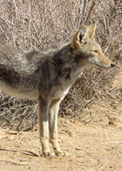
Desert opportunist
The desert's most successful opportunist is the coyote. Its skill as a hunter for anything that can be swallowed ensures this omnivore's survival. The coyote's diet may include insects, lizards, snakes, birds, rodents, rabbits, carrion, fruit, nuts, grass, or tortises along with just about anything else that can be chewed or torn. Coyotes are famous for their howling but also bark when excited. They hold their tail between their legs while running, and can reach speeds of 40 mph.
: Management of the CDCA
The BLM, an agency in the U.S. Department of Interior, holds management authority over the National System of Public Lands, which is the collective term for BLM’s land holdings nationwide. These lands include the public lands in the California desert on which multiple utility-scale solar facilities have been proposed. The Federal Land Policy and Management Act of 1976 (FLPMA) established the BLM's multiple use mandate to manage the land for resource extraction, recreation, cultural value, and conservation.1 This multiple use mandate creates conflict in that the BLM is called to manage public lands in a manner that will protect ecological and environmental quality, but also allows resource use in a way "that takes into account the long-term needs of future generations for renewable and non- renewable resources," among other considerations.2 While not always mutually exclusive, these provisions present a challenge to the BLM as it considers processing and approving permits for utility- scale installations that will harvest a renewable resource and cause ecological impacts at site and landscape levels. Additionally, in many cases, these facilities conflict with existing uses of the land.
The California Desert Conservation Area (CDCA) has a complex history of statutes, regulations, and management plan designations and prescriptions guiding the management of the various federally owned lands within the desert. Within the BLM, the California state office oversees the California Desert District (CDD) office, which is itself responsible for the five field offices that fall within the CDD and the management of the CDCA.
The 1980 California Desert Conservation Area Plan (CDCA Plan) guides management of the CDCA, though more detailed resource management plans exist for specific regions within the CDCA. These include the West Mojave, Northern and Eastern Mojave, Northern and Eastern Colorado, Western Colorado Desert, Coachella Valley, and Imperial Sand Dunes Plans.
CDCA Multiple-Use Classes
The CDCA Plan divides BLM lands into four multiple-use classes:3
1. Class C (Controlled Use) lands include Wilderness Areas and areas "preliminarily recommended" for wilderness by Congress, such as Wilderness Study Areas (WSAs).4 There are approximately four million acres of Class C lands.5
2. Class L (Limited Use) lands protect "natural, scenic, ecological, and cultural resource values."6 The lands are "managed to provide for generally lower-intensity, carefully controlled multiple use of resources, while ensuring that sensitive values are not significantly diminished."7 There are approximately four million acres of Class L lands.8
3. Class M (Moderate Use) lands provide a "controlled balance between higher intensity use and protection of public lands."9 They allow for energy and utility development, among other uses. There are approximately 1.5 million acres of Class M lands.10
4. Class I (Intensive Use) lands "provide concentrated use of lands and resources to meet human needs."11 There are approximately 500,000 acres of Class I lands.12
Scattered parcels of land that do not fall into one of these four categories are designated "unclassified" and are managed on a case-by-case basis.
The CDCA Plan stipulates that solar energy development is not allowed on Class C lands, but may be allowed on Class L, M, or I lands after NEPA requirements are met.13 While the CDCA Plan allows for solar development, this allowance did not consider the impacts of current technologies and acreage necessary for utility-scale solar today.14 As Class L lands are designated for “lower-intensity, carefully controlled multiple use of resources,” an argument can be made for interpretation of the plan to prohibit utility-scale solar development on Class L lands. While it is an issue being discussed, one BLM field office manager noted, "The initial indication from the [California Desert] District was that solar energy would be in conformance with both the M and the L classes. It could be done, and an amendment [to the CDCA Plan] may not or should not be necessary. These things can all be looked at on a case by case basis."15
1 U.S. Department of the Interior, Bureau of Land Management and Office of the Solicitor, The Federal Land Policy and Management Act, as amended. U.S. Department of the Interior, Bureau of Land Management Office of Public Affairs, 2001 (Washington, D.C.), 69.
2 U.S. Department of the Interior, Bureau of Land Management and Office of the Solicitor, The Federal Land Policy and Management Act, as amended. U.S. Department of the Interior, Bureau of Land Management Office of Public Affairs, 2001 (Washington, D.C.), 69.
3 U.S. Bureau of Land Management, California Desert Conservation Area Plan, 1980, as amended, 1999, http://www.blm.gov/pgdata/etc/medialib/blm/ca/pdf/cdd/cdcaplan.Par.15259.... 4 U.S. Bureau of Land Management, California Desert Conservation Area Plan, 1980, as amended, 1999, http://www.blm.gov/pgdata/etc/medialib/blm/ca/pdf/cdd/cdcaplan.Par.15259....
5 U.S. Bureau of Land Management, The California Desert Conservation Area, http://www.blm.gov/ca/st/en/fo/cdd/cdca_highlights.html.
6 U.S. Bureau of Land Management, California Desert Conservation Area Plan, 1980, as amended, 1999, http://www.blm.gov/pgdata/etc/medialib/blm/ca/pdf/cdd/cdcaplan.Par.15259....
7 U.S. Bureau of Land Management, California Desert Conservation Area Plan, 1980, as amended, 1999, http://www.blm.gov/pgdata/etc/medialib/blm/ca/pdf/cdd/cdcaplan.Par.15259....
8 Bureau of Land Management, The California Desert Conservation Area, http://www.blm.gov/ca/st/en/fo/cdd/cdca_highlights.html.
9 U.S. Bureau of Land Management, California Desert Conservation Area Plan, 1980, as amended, 1999, http://www.blm.gov/pgdata/etc/medialib/blm/ca/pdf/cdd/cdcaplan.Par.15259....
10 U.S. Bureau of Land Management, The California Desert Conservation Area, http://www.blm.gov/ca/st/en/fo/cdd/cdca_highlights.html.
11 U.S. Bureau of Land Management, California Desert Conservation Area Plan, 1980, as amended, 1999, http://www.blm.gov/pgdata/etc/medialib/blm/ca/pdf/cdd/cdcaplan.Par.15259....
12 U.S. Bureau of Land Management, The California Desert Conservation Area, http://www.blm.gov/ca/st/en/fo/cdd/cdca_highlights.html.
13 U.S. Bureau of Land Management, California Desert Conservation Area Plan, 1980, as amended, 1999, http://www.blm.gov/pgdata/etc/medialib/blm/ca/pdf/cdd/cdcaplan.Par.15259....
14 U.S. Bureau of Land Management Staff Member 8, Personal Communication, July 29, 2009.
15 U.S. Bureau of Land Management Staff Member 6, Personal Communication, July 29, 2009.
